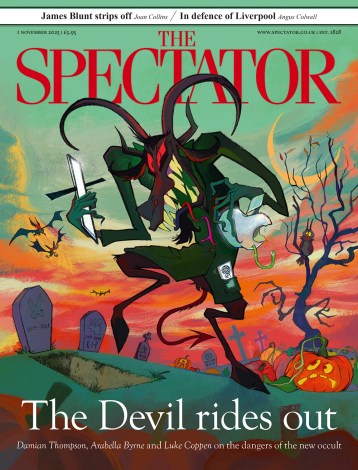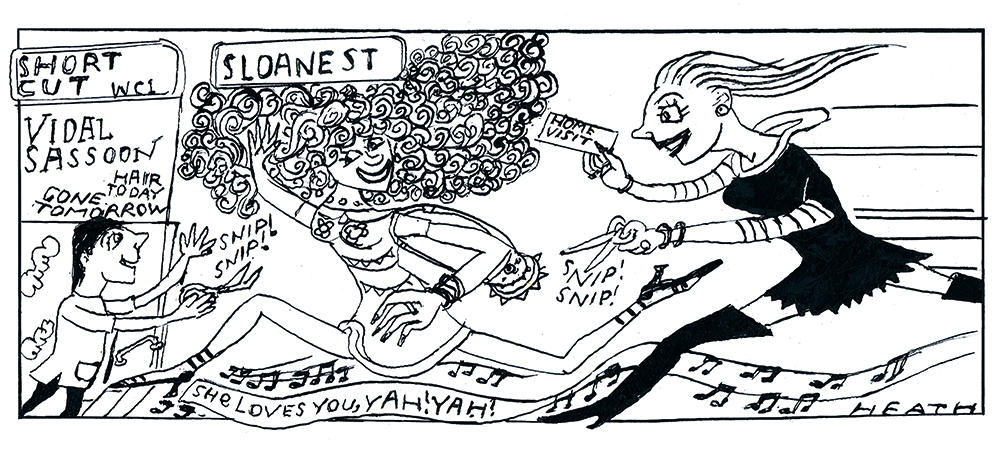‘How would you like your hair cut?’ ‘In silence.’ So goes the ancient joke. My answer, however, is ‘at home’. You see, this week marks the 15th anniversary of having my hair cut in my Highgate flat by the great Jane Davies, peripatetic barber to London’s loucher gentry. (Just as Jeeves is not a butler, so Jane is not a hairdresser.) In 1970, Jane left her Cromwell Road convent and, with scissors in hand, descended to a smoke-filled basement on Sloane Street. Here Vidal Sassoon had established a speakeasy barbershop for men who wanted their locks left groovily long. Some 15 years later, Jane went freelance, but rather than open a salon or hire a chair, she visited her clients at home. Such domesticity suits a snipper-up of unconsidered trifles, and Jane is blessed with a miscellanist’s mindset and Borgesian library of books, pamphlets, clippings and photographs. It’s not uncommon to return home to a hand-delivered oddity relating to a recent mid-cut conversation; her envelopes are always labelled ‘Hair Mail’.
Like a mafia hitman, Jane acquires her clients through word of mouth. And like a Savile Row tailor, she is discretion itself – yet never so discrete as to be dull. Over the years, to facilitate an introduction or extend an invitation, names are slipped deftly into conversation. (Death permits me to disclose Robin de La Lanne-Mirrlees, Harold Evans and Jim Henson.) But the true extent of her network is shrouded in mystery. Indeed, if Jane did not exist, we would need Greene or le Carré to invent her. Lunching recently at the Garrick, I spotted three of her other clients. And those were just the names I knew.
Speaking of clubs, something is afoot in clubland. Not the lingering debate about women members, nor the cost of staffing and heating cavernous palazzi. The problem is the absurd proliferation of enterprises that walk like clubs and talk like clubs but are not clubs at all. Such sleight of brand covers everything from the sublime 5 Hertford Street (ruled by the velvet fist of Robin Birley) to the ridiculous Soho House (which boasts a global waiting list of 98,000). Hard to join but easy to use, genuine clubs are microcosms of mutual simpatico. Most significantly they are owned by – and run for – their members, who decide upon every detail from the make-up of the membership to the mark-up on the wine. By contrast, ersatz establishments like Nikita, Apollo’s Muse and Ten Trinity Square are for-profit businesses operated for the benefit of their owners. Perhaps pseudo-club members don’t realise they’re paying someone else’s mortgage, perhaps they don’t care. After all, the private club in New York’s Aman hotel costs $200,000 to join, and then $15,000 a year. But ownership is axiomatic. In 1824, when members of London’s Stratford Club had exhausted their patience with the unclubbable antics of Major General Thomas Charretie, they deployed the nuclear option. The committee met, voted to dissolve the club entirely, and instantly formed a new establishment – the Portland Club – with an identical membership, bar one. Try doing that with the 255,300 members of Soho House.
‘Doors on or off?’ This was not a question I expected as I walked to the helicopter. Of course, the only sensible answer is ‘off’ – not just to experience a cockpit blasted with ice-cold air, but to photograph Alaska’s awe-inspiring Knik Glacier without the window’s reflective glare. Alaska was but one location in a year of adventurous travel, which took in Antarctica, India, Turkey, Greece, Italy and Spain. For many years I didn’t really know how to travel. I found myself in Paris or Rome, but was unsure of how to be. And then I returned to my roots as a photographer, deploying not the omnipresent (and omnidistracting) iPhone but a clunky Nikon SLR with a heavy zoom lens. The difference was dramatic. A proper camera is an anchor and a catalyst. Whether snapping portraits of socialites at the Seville Feria, framing the epic desolation of the Drake Passage, or shooting gully cricket in Kolkata, a camera slows you down and encourages you to interact with your surroundings.
Only because I had a camera did it occur to me to chat with Süleyman Cinci, who since 1979 has been a fixture of Istanbul’s Grand Bazaar. Born visually impaired, Süleyman has made a living selling chocolates, tissues and other useful items; in 2005 he added a digital weighing scale to his cart, to cater for locals and tourists eager to keep trim. In the pandemic, he began selling masks and increased his stock of kolonya – the Ottoman-era cologne which the pandemic transformed from symbol of hospitality to life-saving balm. Without a camera, I would never have plucked up the gumption to talk to Süleyman, nor learn his remarkable story. I don’t usually do New Year’s resolutions, but if I did, ‘Doors off, camera up’ would be a start.






Comments